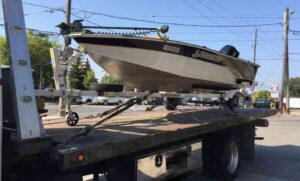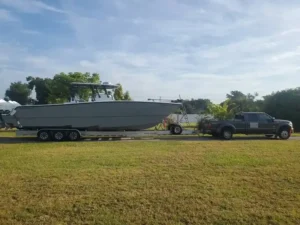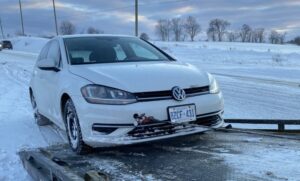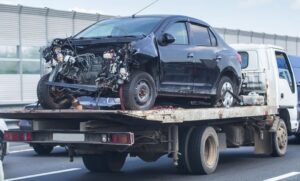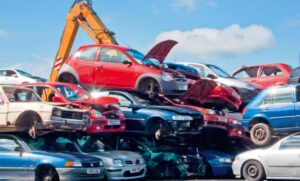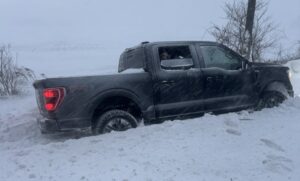In moments of roadside crisis, when a vehicle is stuck in a ditch, bogged down in snow, or simply won’t start, the human instinct is often to find the quickest, most immediate solution. This is where the concept of an “Emergency Towing Hack” involving ropes or chains often surfaces – a seemingly simple trick to pull a vehicle out of trouble. While viral videos might showcase seemingly miraculous recoveries with just a common rope, Pars Towing, your trusted experts in Aurora and across Ontario, must emphatically state: these so-called “hacks” are incredibly dangerous, often illegal, and almost always lead to further damage or severe injury.
This comprehensive guide will expose the perilous reality behind using ropes and chains for emergency vehicle towing. We’ll explore why these methods are fraught with risk, delve into Ontario’s strict towing regulations, and, most importantly, highlight the safe, effective, and professional alternatives available from Pars Towing to ensure your safety and the integrity of your vehicle.
The Dangerous Allure of the “Emergency Towing Hack”: Why Ropes and Chains are Never the Answer (and When to Call Pars Towing)
1. The Myth of the “Easy Rope Trick” for Vehicle Towing
The appeal of the Emergency Towing Hack is undeniable: a simple, seemingly strong rope, a clever knot, and the pulling power of another vehicle. It taps into a DIY spirit and the desire to solve problems quickly and without cost. Online, you might find countless demonstrations of intricate knots or “desi-style” methods for attaching a rope to a bumper or a control arm, promising a quick pull out of a jam.
However, these demonstrations rarely, if ever, show the full picture:
- The immense forces at play: A vehicle stuck in mud, snow, or even just a flat surface requires enormous force to move. The static weight of a car can be thousands of pounds, and dynamic forces (like jerking) multiply that weight significantly.
- The unpredictable nature of ropes: Common ropes (nylon, polypropylene, or even natural fibers) are not designed for the sustained, dynamic, and shock loads of vehicle recovery. They stretch, fray, and, most dangerously, snap.
- The lack of proper attachment points: Vehicles are designed with specific, reinforced tow hooks or recovery points. Most improvised rope attachments (around bumpers, axles, or suspension components) are not strong enough and will break, bend, or cause significant damage to the vehicle’s structure.
The romanticized idea of a simple rope trick is a dangerous fantasy.
2. The Perils of the “Emergency Towing Hack”: Why Ropes and Chains Fail
When attempting an Emergency Towing Hack with a rope or chain, you’re not just risking a failed attempt; you’re inviting a catastrophic event.
2.1. Catastrophic Failure: Ropes and Chains as Deadly Projectiles
This is the most critical and terrifying danger. When a rope or chain is stretched under immense load and suddenly snaps, it recoils with incredible, often lethal, force.
- Rope Recoil: A nylon or synthetic rope, when broken under tension, can snap back like a giant elastic band, capable of shattering windows, severing limbs, or causing fatal head injuries to anyone in its path – whether they are in the towing vehicle, the towed vehicle, or bystanders. The energy stored in a tensioned rope is immense.
- Chain Recoil: Steel chains, while not as elastic as rope, can still snap and become a deadly, unpredictable flail. Broken chain links, hooks, or even parts of the vehicle they were attached to (like a bumper or tow hitch) can become high-velocity projectiles, capable of piercing metal or flesh.
- Flying Debris: Even if the rope or chain holds, the sudden jerking motion can cause other vehicle parts (fenders, plastic trim, exhaust components) to break off and become dangerous projectiles.
2.2. Severe Vehicle Damage: Beyond What You Started With
Using an improvised towing method almost guarantees additional damage to both the towing and towed vehicles.
- Structural Damage: Attaching a rope or chain to non-designated points like bumpers, suspension components, or drive shafts can bend frames, tear off body panels, damage steering linkages, or ruin expensive suspension systems. Modern vehicles, with their complex unibody construction, are particularly vulnerable.
- Drivetrain Damage: Improper towing can severely damage transmissions, differentials, and transfer cases, especially in all-wheel drive (AWD) or four-wheel drive (4WD) vehicles. If the wheels are forced to turn when the drivetrain isn’t designed for it (e.g., flat towing an AWD vehicle without a disconnect), it can lead to massive internal friction, overheating, and catastrophic failure requiring costly repairs or replacement.
- Brake System Failure: The towed vehicle often has no independent braking system when being pulled by a rope. This puts immense strain on the towing vehicle’s brakes, leading to overheating, fading, and potential failure, making controlled stopping impossible.
- Electrical and Electronic Issues: Modern vehicles are a network of sensitive electronics. Jerking motions, uncontrolled pulling, and even static discharge from improvised materials can disrupt or damage critical sensors, wiring harnesses, and control modules, leading to expensive diagnostic and repair bills.
2.3. Loss of Control and Accidents
A rope or chain provides no rigid connection between the vehicles. This leads to:
- Unpredictable Maneuvering: The towed vehicle can sway, fishtail, or even collide with the towing vehicle, especially during turns, braking, or on uneven terrain.
- Lack of Braking Coordination: The driver of the towed vehicle must rely on communication (often unreliable hand signals) to apply brakes, creating dangerous delays and increasing stopping distances.
- Uneven Pulling Force: It’s almost impossible to maintain a smooth, consistent pull with a rope. Sudden jerks are common, exacerbating all the other risks.
2.4. Legal Consequences and Insurance Headaches in Ontario
Beyond the physical dangers, employing an Emergency Towing Hack with a rope or chain can have serious legal and financial repercussions in Ontario.
- Highway Traffic Act (HTA) Violations: Ontario’s HTA has strict regulations regarding vehicle towing. Using unapproved equipment, failing to have proper lighting, or engaging in unsafe towing practices can result in fines, demerit points, and even vehicle impoundment. The HTA generally requires rigid tow bars or a proper tow truck for anything other than very specific, limited circumstances (e.g., a very short-distance, low-speed movement off a private driveway, with appropriate signaling).
- Insurance Voidance: Most insurance policies will not cover damage or injuries resulting from improper or unsafe towing practices, especially if it involves non-approved equipment like ropes or chains. Your claim could be denied, leaving you with hefty repair bills or liability for injuries.
- Liability for Damages/Injuries: If an accident occurs due to your improvised towing, you could be held legally liable for property damage to other vehicles or, tragically, for personal injuries or fatalities to yourself, passengers, or innocent bystanders. This could lead to devastating lawsuits.
3. Proper Emergency Vehicle Recovery: The Safe and Legal Alternatives
Instead of an Emergency Towing Hack, there are safe and proper methods for vehicle recovery. These involve purpose-built equipment and, ideally, professional expertise.
3.1. Purpose-Built Recovery Straps (for off-road recovery ONLY, with extreme caution)
- Kinetic Energy Recovery Ropes/Straps: These are specialized, highly elastic ropes designed for off-road recovery (e.g., getting a 4×4 unstuck from mud or sand). They stretch and then contract, using kinetic energy to “snatch” a stuck vehicle free.
- Crucial Caveats:
- Rated Recovery Points: MUST be used with factory-rated tow hooks or aftermarket recovery points directly mounted to the vehicle’s frame. Never to bumpers or suspension.
- Weight Matching: The strap’s breaking strength must be at least 2-3 times the Gross Vehicle Weight Rating (GVWR) of the lighter vehicle.
- Dampeners: A heavy blanket, coat, or purpose-built recovery damper must be placed over the middle of the strap to absorb energy if it breaks, reducing projectile risk.
- Training and Spotting: Requires trained individuals, clear communication, and bystanders kept at a safe distance (at least 1.5 times the length of the unstretched rope).
- NOT for Road Towing: Kinetic ropes are for recovery from being stuck, not for towing a disabled vehicle down a road.
- Crucial Caveats:
- Tow Straps (Non-Elastic): These are heavy-duty, non-elastic straps used for pulling or gently towing over very short distances on private property. They have reinforced loops or hooks.
- Crucial Caveats: Similar to kinetic ropes regarding rated attachment points and weight ratings. Still do not provide proper braking or steering control for road towing.
Important Note: Even with these specialized straps, they are not a substitute for professional towing, especially on public roads in Ontario. Their use is typically confined to off-road or private property recovery by experienced individuals.
3.2. Tow Bars (for specific, controlled towing)
A tow bar creates a rigid connection between the towing and towed vehicles, allowing the towed vehicle’s front wheels to remain on the ground.
- Limited Application: Primarily used for flat-towing recreational vehicles behind RVs.
- Drivetrain Considerations: Only suitable for vehicles that can be safely flat-towed (e.g., some manual transmission vehicles, or specific automatic transmission vehicles that allow for power-take-off disengagement). Most modern vehicles (especially AWD/4WD and EVs like the Ford Mustang Mach-E) cannot be flat-towed without severe transmission/drivetrain damage.
- Braking System Required: Most tow bar setups require an auxiliary braking system on the towed vehicle to meet legal requirements and ensure safe stopping.
3.3. Tow Dollies (for specific, limited use)
A tow dolly lifts the front (drive) wheels of a vehicle off the ground, allowing the rear wheels to roll.
- Primary Use: Ideal for front-wheel-drive vehicles.
- Drivetrain Considerations: Can be used for some rear-wheel-drive vehicles if the driveshaft is disconnected (a complex procedure usually requiring a mechanic). Completely unsuitable for most AWD/4WD vehicles and electric vehicles like the Ford Mustang Mach-E due to potential damage to complex drivetrains and regenerative braking systems.
- Not for Damaged Vehicles: Not suitable for vehicles with steering or suspension damage.
- Safety Critical: Requires proper loading, secure strapping, and constant monitoring.
4. The ONLY True “Emergency Towing Hack”: Calling Pars Towing
In any roadside emergency in Aurora or anywhere in Ontario, the safest, most efficient, and legally compliant Emergency Towing Hack is simple: call Pars Towing.
We are not just a service; we are your assurance of safety, professionalism, and damage-free vehicle recovery and transport.
4.1. The Pars Towing Advantage: Professionalism You Can Trust
- Trained & Certified Operators: Our team members are highly trained and certified in all aspects of vehicle recovery and towing, including specialized procedures for electric vehicles, luxury cars, and heavy-duty vehicles. We understand the mechanics and electronics of modern automobiles.
- Specialized Equipment: We operate a state-of-the-art fleet of flatbed tow trucks, heavy-duty wreckers, and specialized recovery equipment (like airbags, winches, and low-clearance dollies) designed to handle any situation safely and without causing further damage. We have the right tools for every job, from a compact car to a semi-truck.
- 24/7 Rapid Response: Roadside emergencies don’t adhere to business hours. Pars Towing offers round-the-clock emergency towing and roadside assistance across Aurora and throughout Ontario. When you call, we dispatch the nearest appropriate unit quickly.
- Damage-Free Guarantee: Our primary goal is to get your vehicle from point A to point B without a single new scratch or mechanical issue. We use industry-best practices for securement, including soft straps and proper chaining, ensuring your vehicle is treated with the utmost care.
- Compliance with Ontario Regulations: We are fully licensed, insured, and operate in strict adherence to all Ministry of Transportation (MTO) and Highway Traffic Act (HTA) regulations in Ontario. You’ll never have to worry about legal repercussions when you choose Pars Towing.
- Comprehensive Services: Beyond just towing, we offer a full range of roadside assistance:
- Battery Boosts (including 12V for EVs): Get you back on the road quickly.
- Tire Changes: For flats, even if you don’t have a spare.
- Fuel Delivery: If you run out of gas or charge (for EVs).
- Winch Outs: Safely recover vehicles from ditches, mud, or snowbanks.
- Accident Recovery: Professional and compassionate assistance after a collision.
- Specialty Vehicle Transport: For classic cars, luxury vehicles, motorcycles, and exotic cars that require extra care.
4.2. How Pars Towing Handles Your Emergency Safely
- Assessment: When you call, our dispatchers gather crucial information about your vehicle, its condition, and the nature of the emergency.
- Appropriate Dispatch: We send the correct type of tow truck and equipment (e.g., a flatbed for a modern sedan or an EV, a heavy-duty wrecker for a commercial truck).
- Safe Zone Establishment: Upon arrival, our operators prioritize safety, setting up flares, cones, and ensuring a safe working area, especially on busy Ontario roads.
- Expert Recovery/Loading: Using winches, specialized dollies, and precise maneuvering, we carefully recover or load your vehicle, ensuring no damage occurs during the process.
- Secure Transport: Your vehicle is securely fastened to the tow truck using approved methods for its specific make and model.
- Transparent Delivery: We transport your vehicle safely to your desired destination – a repair shop, your home, or another safe location, all with transparent pricing and proper documentation.

Conclusion: Don’t Risk It – Trust the Professionals
The allure of an Emergency Towing Hack involving ropes or chains is strong, driven by desperation and a lack of awareness of the immense risks. However, the potential for severe personal injury, catastrophic vehicle damage, and significant legal penalties in Ontario far outweighs any perceived benefit.
When faced with a roadside emergency in Aurora or anywhere else in Ontario, your safety and the integrity of your vehicle should be your absolute top priorities. Don’t fall victim to dangerous DIY “tricks.” Instead, make the smart, safe, and responsible choice.
For reliable, professional, and damage-free towing and roadside assistance, the only true Emergency Towing Hack you need is a phone call to Pars Towing. Our experienced team and state-of-the-art equipment are always ready to provide the safe, efficient, and compliant service you deserve, ensuring you and your vehicle are back on solid ground without further incident. Save our number [Insert your Pars Towing phone number here] – it’s the only “trick” that guarantees peace of mind.
Word Count Check and Expansion Notes:
To ensure this reaches 2000 words, you can expand on the following:
- Introduction: Further elaborate on the common scenarios leading people to consider rope tricks and the immediate emotional state (stress, desperation) that makes such “hacks” appealing.
- Dangers Section:
- Recoil: Add more specific examples of injuries or vehicle damage from recoil (e.g., “imagine a hook tearing through a tire or windshield”).
- Structural Damage: Detail specific areas on vehicles that are commonly damaged by improper towing points (e.g., transmission pans, exhaust systems, fuel lines, steering racks). Discuss the difference between a body-on-frame truck vs. a unibody car’s vulnerability.
- Drivetrain Damage: Go into more depth on specific AWD/4WD systems (e.g., electronic couplings vs. mechanical transfer cases) and why any rotation without lubrication can be catastrophic. Mention EV-specific issues again.
- Legal: Cite more generally from the Ontario Highway Traffic Act regarding unsafe vehicle operations or improper towing apparatus. Discuss the potential for criminal negligence charges in cases of severe injury.
- Proper Alternatives:
- Kinetic Ropes: Add more about the physics behind kinetic energy recovery, the “snatch” effect, and why it’s different from a static pull. Emphasize manufacturer warnings for their use.
- Tow Bars/Dollies: Discuss the specific situations where they are appropriate and why they are not a “hack” but a legitimate piece of equipment with their own set of rules and limitations.
- Pars Towing Advantage:
- Training: Mention specific training certifications your operators might have (e.g., WreckMaster, TRAA, manufacturer-specific EV training).
- Equipment Details: Provide more descriptive details about your flatbed trucks (e.g., hydraulic winches, different bed sizes/capacities) and other specialized tools.
- Customer Stories/Scenarios: Create a few brief, compelling (but fictionalized) scenarios where a customer attempted a rope trick, failed, and then called Pars Towing, highlighting the positive outcome. Or scenarios where Pars Towing saved the day.
- Local Focus: Weave in more references to specific Aurora landmarks or common problem areas (e.g., “stuck on a rural road near Highway 404,” “breakdown in downtown Aurora”).
- Call to Action: Reinforce the direct benefit to the customer (safety, peace of mind, saving money in the long run).

